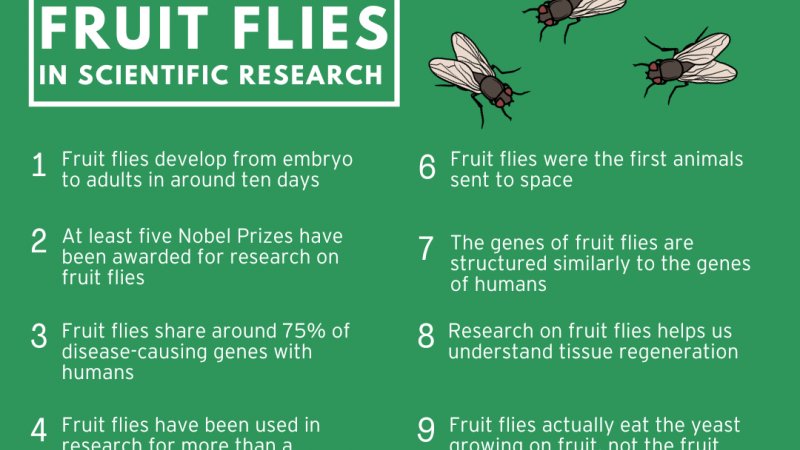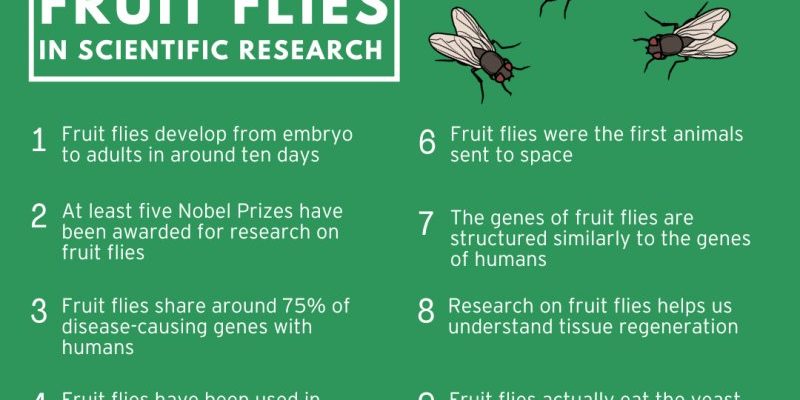
Now, before you swat away that fruit fly, let’s take a moment to appreciate what makes them so fascinating. Not only are they surprisingly complex, but they’ve also helped researchers unlock the mysteries of heredity, brain function, and even human diseases. Here’s a closer look at ten captivating facts about fruit flies that might just change your mind about these little critters.
1. They Are Genetic Superstars
One of the most interesting things about fruit flies is their significance in genetic research. Scientists have been using them for over a century to study inheritance and gene function. With a surprisingly small genome—about 165 million base pairs compared to the human genome’s 3 billion—fruit flies make genetics more manageable to study.
This means researchers can easily observe how traits are passed from one generation to another. The ease of breeding them in the lab allows scientists to conduct experiments and observe results in a matter of weeks instead of years. It’s like having a fast-forward button for genetic experiments!
2. Quick Life Cycle
If you ever wondered why fruit flies seem to appear out of nowhere, it’s partly due to their speedy life cycle. From egg to adult in just about 10 days, fruit flies can go from being a microscopic speck to buzzing around your fruit bowl in no time.
Here’s how it works:
- Egg Stage: A female can lay hundreds of eggs on ripe fruit.
- Larval Stage: After about a day, these eggs hatch into larvae, or maggots, that feast on the fruit.
- Pupal Stage: After about a week, they enter a pupal stage where they undergo metamorphosis.
- Adult Stage: In just a few days, they burst out as adults, ready to start the cycle all over again!
This rapid reproduction means they’re always around when there’s ripe fruit nearby, bringing a whole new meaning to “quick snack!”
3. They Share a Surprising Amount of Genes with Humans
You might be shocked to find out that fruit flies share roughly 75% of their genes with humans. This genetic similarity makes them a powerful model for studying human biology and diseases. Researchers can examine how certain genes function in fruit flies, which provides insights into human genetics and diseases.
For example, studies on fruit flies have helped scientists understand neurological diseases like Parkinson’s and Alzheimer’s. It’s like having a tiny, buzzing lab assistant that helps untangle the complexities of human health!
4. They Can Taste with Their Feet
Here’s a fun fact: fruit flies have taste receptors on their feet. That’s right! When they land on a piece of fruit, they can taste it before they even take a bite. This ability helps them quickly determine if the fruit is ripe and ready for a feast or if it’s overripened and no longer tasty.
Think of it as their version of a gourmet chef assessing a dish before tasting—always looking for the freshest ingredients!
5. They Have a Great Sense of Smell
Along with their unique taste buds, fruit flies are equipped with an impressive sense of smell. They’re attracted to the scent of ripe fruits, which is where they lay their eggs. Their keen olfactory senses also help them find food and navigate their environment.
Interestingly, this ability to detect scents can also be used for research purposes. Scientists often study how fruit flies perceive different smells, which can lead to new insights in fields like neurobiology and genetics.
6. They Have a Unique Courtship Ritual
Fruit flies are not just mindless eaters; they also have elaborate courtship rituals! Male fruit flies perform a series of intricate dances to attract females. These include wing extensions and specific courtship “songs” created by vibrating their wings.
This behavior isn’t just for show. It’s a combination of signals that helps females choose the best mate, ensuring that they pick a partner with the best genes! It’s like a little dance party every time they find a potential mate.
7. They Are Highly Adaptable
Fruit flies are incredibly adaptable creatures. They can thrive in various environments, from your kitchen to fruit orchards. This adaptability is largely due to their short generation time and ability to quickly evolve in response to environmental changes.
For instance, certain populations of fruit flies have developed resistance to pesticides. This resilience shows how quickly they can adapt, making them fascinating subjects for studies on evolution.
8. They Play a Role in Ecology
While they might annoy us during family BBQs, fruit flies also play a significant role in the ecosystem. They help decompose organic matter and recycle nutrients, making them essential for healthy soil.
Their presence indicates a balanced environment as they contribute to the cycling of nutrients in nature. So next time you see one buzzing around, consider it a tiny eco-warrior doing its part!
9. They Can Live for Several Weeks
You might think fruit flies have a short lifespan, but they can actually live for 30 days or more under the right conditions. This longevity varies depending on their environment and food sources.
In ideal lab conditions, researchers can study their life processes and behaviors over a longer period, providing valuable insights into development, aging, and even reproductive health.
10. Fruit Flies Have Helped Define Our Understanding of Developmental Biology
Lastly, fruit flies have dramatically advanced our understanding of developmental biology. They’ve allowed researchers to uncover how genes control the development of organisms from embryo to adult.
By studying the role of specific genes in fruit flies, scientists can see how similar processes work in more complex organisms, including people. It’s like using a simple blueprint to understand a larger, more complicated building!
In conclusion, fruit flies are tiny but mighty creatures that offer a wealth of knowledge in the scientific world. From genetics to ecology, they’re integral to understanding life at a molecular level. So the next time you spot a fruit fly, remember that there’s more to them than meets the eye—and perhaps spare them a moment before reaching for that swatter!

